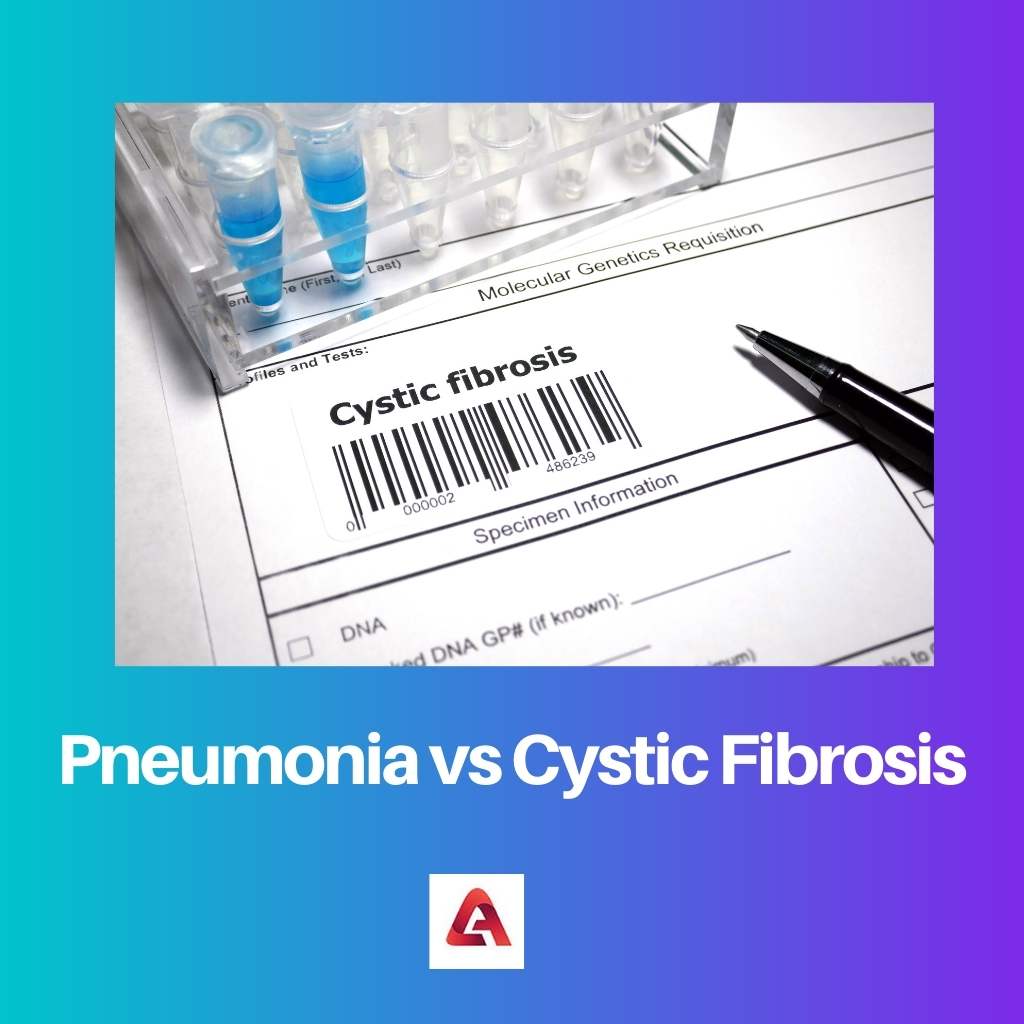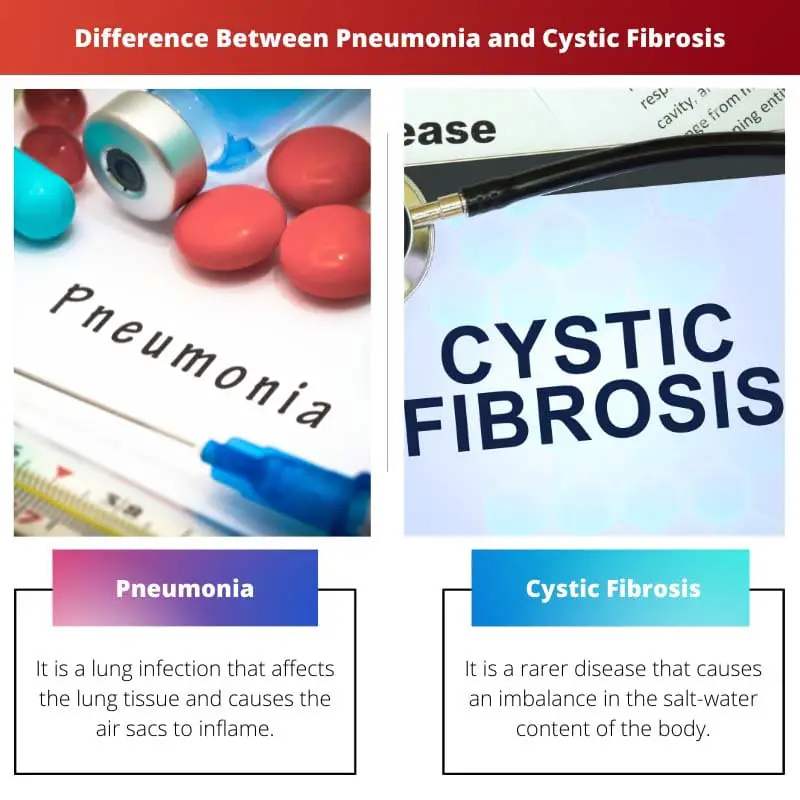Respiratory diseases are some of the most common types of diseases that affect the most number of people at any given time.
The respiratory system is highly prone to diseases because, with every breath we take, millions of particles, micro-organisms, pollen particles, etc., enter the system, with the potential to cause damage to the system.
Key Takeaways
- Pneumonia is an infection of the lungs, while cystic fibrosis is a genetic disorder that affects the respiratory system.
- Bacteria, viruses, or fungi can cause pneumonia, while a faulty gene causes cystic fibrosis.
- Pneumonia can be treated with antibiotics, while there is no cure for cystic fibrosis.
Pneumonia vs Cystic Fibrosis
Pneumonia is a medical term that is used to describe an infection that affects the lungs by creating inflammations in the air sacs, and it is caused by fungi, bacteria, and viruses. Cystic fibrosis is a rare disease that leads to an imbalance in the water and salt content of the human body.

Pneumonia is a common disease, and the causes of pneumonia can be anything from a bacterial infection to a strong fever. It is a lung infection and produces damage to the lung tissues.
Pneumonia causes inflammation of the air sacs, which get filled with water or pus. This produces difficulty in breathing, heavy coughs, increased production of phlegm, and heavy fever.
Cystic Fibrosis is a rare disorder. It causes an imbalance in the salt and water level in the body. The salt and water are not absorbed properly by the cells present in the kidneys, liver, pancreas, sweat glands, and lungs.
This produces an imbalance in the salt-water content of the body, leading to an increase in the sodium content and mucus content, blocking the nasal pathway.
Comparison Table
| Parameters of Comparison | Pneumonia | Cystic Fibrosis |
|---|---|---|
| Definition | It is a lung infection that affects the lung tissue and causes the air sacs to inflame | It is a rarer disease that causes an imbalance in the salt-water content of the body |
| Area of infection | The lung tissue is targeted | Affects the gene that is responsible for salt-water absorption in the body |
| Type of Disease | Infection of the lungs | Genetic Mutation |
| Caused by | Viruses, bacteria, fungi | Inherited from mutated genes |
| Symptoms | High fever, chest pain, phlegm in cough, breathing difficulty, vomiting | Salty sweat, high production of mucus in the airways, reduced levels of chloride secretion in the lungs, coughing, phlegm |
What is Pneumonia?
Pneumonia is an infection of the lungs, and it damages the lung tissue. Pneumonia causes inflammation of the air sacs present in the lungs. The sacs get filled with water or pus, which causes heavy coughing and phlegm in cough.
This leads to further complications such as difficulty in breathing, high fever, nausea, vomiting, trembling, chest pain, etc.
There are many reasons for pneumonia. Some of the prime causes of pneumonia are viruses and bacteria in the environment. Micro-organisms present in the environment are sucked into the lungs while breathing.
These micro-organisms damage the lung tissues, which then causes the inflammation of the damaged air sacs. The air sacs get filled with purulent material and water, which leads to pus formation and phlegm.
Pneumonia is a serious infection and can become life-threatening if not treated right away. Infants under the age of 2 years and elderly above the age of 65 are most affected by pneumonia.
Symptoms of pneumonia include chest pain, breathing difficulty, phlegm in cough, fatigue, nausea, vomiting, high fever, sweating, and overall weakness. In some rare instances, the patient doesn’t show any symptoms. This
Pneumonia can be cured by getting vaccinated before the complications increase. Many vaccines are available that prevent different types of pneumonia, and seeking a doctor before the situation worsens is the best way to go.

What is Cystic Fibrosis?
Cystic Fibrosis is a much rarer disorder, with fewer than a million cases per year. It is a genetic disorder and is caused due to gene mutation. It is a chronic disorder, and in some cases, it can have lifelong effects on the body.
It is a genetic mutation and is not caused due to bacteria or fungi. It is passed down through the genes and can only affect members of the same family.
Cystic Fibrosis affects the cells that absorb salt and water in the organs such as the liver, kidney, pancreas, and sweat glands. The gene which is responsible for this function gets mutated during cystic fibrosis.
It affects the water and salt absorption capabilities of the body and creates an imbalance in the salt-water content of the body.
This affects the lungs as the chloride secretion of the cells in the lining of the airways is reduced, due to which there’s an increase in the absorption of sodium.
This creates an increase in the salt content in the mucus in the lining of the airways and a reduction in the water content. The mucus becomes thick and gets coagulated in the airways, blocking the path and leading to shortness of breath.
If the mucus is not cleared, breathing complications increase, along with a lowering of the body’s immune system and an increase in the vulnerability of the body to other diseases.
Main Differences Between Pneumonia and Cystic Fibrosis
- Pneumonia is a lung infection, and it affects the lung tissues. Cystic Fibrosis is a genetic disorder, and it causes an imbalance in the salt-water content in the body.
- In pneumonia, the main target of the infection is the lung tissue. In cystic fibrosis, the main target is the gene that is responsible for salt-water absorption
- Pneumonia is an infection and is caused by viruses, bacteria, etc. Cystic Fibrosis is a genetic disorder and is inherited from parents.
- The occurrence of pneumonia is very common, with over 10 million cases per year. The occurrence of Cystic fibrosis is rare, with about 1 million cases per year
- Symptoms of Pneumonia are phlegm in cough, heavy fever, chest pain, breathing difficulty, etc. Symptoms of Cystic Fibrosis are salty sweat, thick and more quantity of mucus, and high sodium levels in the blood.

- https://www.sciencedirect.com/science/article/pii/S0140673610614596
- https://www.nejm.org/doi/full/10.1056/NEJM199512143332408
- https://www.atsjournals.org/doi/abs/10.1164/rccm.200505-840OE
- https://www.sciencedirect.com/science/article/pii/S002234760583478X

The comparison between the symptoms of pneumonia and cystic fibrosis is enlightening. It’s important for individuals to recognize the signs and seek appropriate medical care.
Absolutely, the distinction in symptoms can assist in differentiating between these conditions. This knowledge can guide individuals in seeking professional help.
Respiratory diseases indeed pose a significant health risk to the general population. Pneumonia and cystic fibrosis are both serious conditions that can have severe consequences if not treated properly.
The comparison table outlining the differences between pneumonia and cystic fibrosis is very informative. This helps in understanding the distinctions between these two conditions.
I completely agree. It’s important for people to be aware of the symptoms and causes of these diseases to seek medical help as soon as possible.
The comprehensive description of pneumonia and cystic fibrosis aids in raising awareness about these diseases. Knowledge empowers individuals to take proactive measures for their health.
Awareness is the first step in combating respiratory diseases. This article promotes awareness and understanding of pneumonia and cystic fibrosis.
Both medical professionals and the public can benefit from the educational value of this content. There is immense value in understanding respiratory diseases.
Thank you for shedding light on the differences between pneumonia and cystic fibrosis. Both diseases are serious and require medical attention. This article provides valuable insights.
I appreciate the emphasis on preventive measures such as vaccinations for pneumonia. It’s essential to take proactive steps to protect against respiratory infections.
The description of cystic fibrosis and its genetic nature is well articulated. Understanding the genetic basis of the disease can help in early diagnosis and intervention.
The valuable insights provided in this article can help individuals make informed decisions about their respiratory health. Awareness is key in disease prevention.
Absolutely, knowledge about common respiratory diseases is essential for maintaining good health. This content contributes to public health awareness.
The clear distinction between pneumonia and cystic fibrosis provided here is commendable. This content serves as an educational resource for many.
Absolutely, the educational value of this article is significant in promoting understanding and proactive measures against these diseases.
The elaboration on cystic fibrosis and its impact on salt and water absorption is insightful. Understanding the underlying mechanisms of the disease is crucial.
The information on preventive measures and vaccines for pneumonia is crucial. Promotion of preventive healthcare can play a significant role in reducing the burden of respiratory diseases.
Absolutely, preventive measures form an essential component of public health initiatives. The emphasis on vaccinations is important for disease control.
The content provides a comprehensive overview of pneumonia and cystic fibrosis. The symptoms and causes are well-explained, which is crucial for understanding these respiratory diseases.
Yes, it’s important for individuals to educate themselves about these diseases, especially if they have a family history of cystic fibrosis. Early detection and management are key.
As a healthcare professional, I find the detailed explanations of these respiratory diseases to be accurate and valuable for both medical practitioners and the general public.
Agreed, the information presented here is beneficial for increasing awareness and understanding of pneumonia and cystic fibrosis.
The comparison table between pneumonia and cystic fibrosis simplifies the disparities between these diseases, making it easier for people to understand the unique characteristics of each condition.
I agree, the clarity in presenting the differences in symptoms and causes is highly beneficial for increasing awareness and understanding.